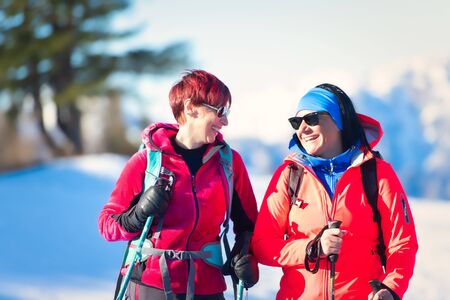1. Check Weather Conditions and Trail Information
Before you head out for a winter hike in the US, it’s crucial to know exactly what to expect from both the weather and the trail. Winter conditions can change quickly, and being prepared makes all the difference between a safe adventure and a risky outing.
How to Get Accurate Weather Updates
Use reliable sources to find up-to-date forecasts for your specific hiking area. Some trusted resources include:
| Resource | Website or App | What It Offers |
|---|---|---|
| National Weather Service (NWS) | weather.gov | Detailed local forecasts, alerts, and warnings |
| NOAA Weather Radio | NOAA Radio Device/App | 24/7 official weather updates for outdoor users |
| The Weather Channel | weather.com | User-friendly interface for quick checks |
| Local News Stations | TV/Online Apps | Region-specific alerts and conditions |
Check Trail Reports Before You Go
A lot of US trails have unique winter risks such as ice, snowdrifts, or seasonal closures. Always look up recent trail reports:
- National Park Service (NPS): Visit the park’s official website for current trail conditions, closures, and safety advisories.
- Local Hiking Clubs: Groups like the Appalachian Mountain Club or Sierra Club often share firsthand trail updates.
- Online Platforms: Websites like AllTrails or local Facebook hiking groups provide real-time hiker feedback.
- Ranger Stations: Call ahead or stop by for the latest info on snowpack, avalanche risk, and wildlife activity.
Understanding Trail Closures and Avalanche Risks
Certain US regions, especially in the Rockies, Cascades, and Sierra Nevada, face high avalanche danger during winter. Look for:
- Avalanche Forecasts: Check with Avalanche.org, which links to regional centers across the US.
- Trail Closures: Obey posted signs or online notices about closed routes due to maintenance or hazardous conditions.
- Seasonal Restrictions: Some trails close for wildlife protection or heavy snowfall—always respect these rules.
Your Local Resource Guide: Where to Check First?
| If You’re Hiking In… | Main Local Source for Info | Avalanche Center Link (if applicable) |
|---|---|---|
| Northeast (White Mountains, Adirondacks) | US Forest Service: White Mountain National Forest | N/A (limited avalanche risk) |
| Pacific Northwest (Cascades) | Mount Rainier NPS Trail Reports | Northwest Avalanche Center (NWAC) |
| Sierra Nevada (Yosemite Area) | Yosemite Trail Conditions Page | Sierra Avalanche Center (SAC) |
| Rocky Mountains (Colorado) | Rocky Mountain NPS Trail Conditions | Colorado Avalanche Information Center (CAIC) |
| Southeast (Smoky Mountains) | Great Smoky Mountains NPS Trail Updates | N/A (minimal avalanche risk) |
If you make checking the weather and trail conditions part of your routine before every winter hike, you’ll set yourself up for a safer—and more enjoyable—adventure in America’s great outdoors.
2. Dress in Layers and Choose the Right Gear
Mastering the Layering System for American Winters
One of the most important rules for winter hiking in the US is dressing in layers. The weather can change quickly, and temperatures can drop fast, especially in places like the Rockies, Appalachians, or Pacific Northwest. A good layering system lets you add or remove clothing as needed to stay warm and dry.
The Three Essential Layers
| Layer | Main Purpose | Recommended Fabrics |
|---|---|---|
| Base Layer | Wicks sweat away from your skin | Merino wool, synthetic (polyester/polypropylene) |
| Insulating Layer | Keeps you warm by trapping body heat | Fleece, down, synthetic insulation |
| Outer Layer (Shell) | Protects against wind, rain, and snow | Waterproof breathable fabrics (Gore-Tex, eVent) |
Selecting the Right Footwear and Traction Devices
Your boots are your best friend on a winter hike. Choose waterproof boots with good insulation and ankle support. If you expect icy trails or packed snow, traction devices like microspikes or crampons are a must for safety. For deep powdery snow, lightweight snowshoes can help you move more easily.
Winter Hiking Footwear Checklist:
- Insulated Waterproof Boots: Keep feet warm and dry in slush or snow.
- Wool or Synthetic Socks: Avoid cotton; it holds moisture and gets cold.
- Traction Devices: Microspikes for icy trails; snowshoes for deep snow.
- Gaiters: Protect your lower legs from snow entering your boots.
Must-Have Accessories for Winter Hikes
The right accessories make a huge difference when hiking in cold conditions across America. Don’t forget these essentials:
- Gloves or Mittens: Layer thin liner gloves under insulated waterproof mittens for warmth and dexterity.
- Warm Hat/Beanie: Fleece or wool hats help retain body heat—remember, much of your heat escapes through your head!
- Neck Gaiter or Buff: Protects your face from windburn and frostbite.
- Sunglasses or Goggles: Snow glare can be intense even on cloudy days; eye protection is key.
- Chemical Hand Warmers: Keep a few packs handy for extra-cold days.
Dressing properly sets you up for a safe and comfortable adventure on Americas winter trails. The right gear not only keeps you warm but also helps you enjoy all the beauty of a snowy hike without worries.

3. Plan Your Route and Share Your Itinerary
Mapping Out Your Hike with US Topographic Platforms
Before you hit the trail, it’s essential to plan your route carefully. In the US, hikers commonly use topographic mapping platforms like AllTrails, Gaia GPS, and official USGS maps. These tools help you see elevation changes, trail intersections, and possible hazards. You can also download offline maps in case you lose cell service. Always double-check for recent trail updates or closures from local park services.
Popular Mapping Platforms for US Hikers
| Platform | Main Features | Best For |
|---|---|---|
| AllTrails | User reviews, photos, downloadable maps | Beginner & Intermediate Hikers |
| Gaia GPS | Detailed topo maps, route planning, offline navigation | Advanced & Backcountry Hikers |
| USGS Maps | Official government topography, high detail | Experienced Navigators |
Estimating Daylight Hours for Winter Hiking Safety
Winter days are short, and darkness can come quickly—sometimes much earlier than you expect! Before your hike, look up sunrise and sunset times for your area. Plan your hike so that you have plenty of daylight to finish safely. A good rule of thumb is to turn around when you reach half your planned hiking time, not distance, since snow and ice can slow you down.
Tip: Carry a headlamp just in case you’re delayed!
Leaving Your Plans with a Trusted Contact
A key part of US hiking culture is always letting someone know where you’re going. Share your route details, expected start and finish times, and emergency contacts with a friend or family member before heading out. This practice is not just for solo hikers—groups should do this too. If something goes wrong, having someone who knows your plans can make all the difference.
4. Pack Smart with Winter Essentials
Checklist: Must-Have Gear for US Winter Hikes
Packing the right gear is a game changer for winter hiking in the US. Weather and terrain can change quickly, so being well-prepared helps you stay safe and comfortable. Use this checklist to make sure you have all the essentials before heading out:
| Item | Why You Need It |
|---|---|
| Navigation Tools (Map, Compass, GPS) | US trails can be confusing in snow—these keep you on track if paths are covered or signs are hard to see. |
| Emergency Blanket or Bivy Sack | Helps retain body heat if you need to stop or get stranded; essential in cold American climates. |
| First Aid Kit | For treating blisters, cuts, or minor injuries common on icy or rocky US trails. |
| Headlamp (with Extra Batteries) | Daylight is shorter in winter; trails get dark fast, especially in forests or mountains. |
| Hand Warmers | Keeps hands warm during long hikes or emergencies—especially important in freezing US regions. |
| High-Energy Snacks | Your body burns more calories in cold weather; bring trail mix, granola bars, or jerky for quick energy. |
| Extra Water (Insulated Bottle Recommended) | Dehydration happens even in the cold; insulated bottles prevent water from freezing on the trail. |
| Multi-tool or Pocket Knife | Useful for repairs or emergencies—always handy when exploring remote US wilderness areas. |
| Whistle and Signal Mirror | For signaling help if you’re lost; these are lightweight and effective tools for American backcountry safety. |
| Sunscreen and Sunglasses | Snow reflects sunlight strongly—even on cloudy days—so protect your skin and eyes from UV rays. |
Why These Essentials Matter in America’s Winter Wilderness
The US has diverse landscapes—from snowy Rocky Mountains to forested national parks. Trail markers might be buried under snow, so navigation tools are a must. Emergency blankets and hand warmers are lifesavers if you get stuck waiting for help. Many popular hiking spots can be miles from cell service, so carrying a whistle, signal mirror, and reliable headlamp is smart planning. Remember to always pack extra layers and check local trail conditions before leaving home. Packing smart lets you focus on enjoying the beauty of America’s winter outdoors while staying prepared for whatever comes your way.
5. Practice Leave No Trace and Respect Wildlife
Understanding Winter Leave No Trace Principles
Winter hiking in the US is a special experience, but it comes with unique responsibilities. The Leave No Trace (LNT) principles are widely followed by American outdoor enthusiasts to protect nature and keep trails beautiful for everyone. Here’s how you can follow LNT during your winter hike:
| LNT Principle | Winter Application |
|---|---|
| Plan Ahead and Prepare | Check weather, trail conditions, and regulations before heading out. Bring extra layers, food, and safety gear. |
| Travel and Camp on Durable Surfaces | Stick to established trails or walk on deep snow to prevent damaging fragile vegetation underneath. |
| Dispose of Waste Properly | Pack out all trash, including food scraps. Use a waste bag for human waste if facilities are closed or buried under snow. |
| Leave What You Find | Don’t pick plants or disturb natural features—winter habitats are delicate. |
| Minimize Campfire Impact | Avoid fires if possible; use a camp stove for cooking. Never burn trash or leave fire scars in the snow. |
| Respect Wildlife | Observe from a distance. Don’t approach, feed, or try to touch animals—even if they seem tame. |
| Be Considerate of Others | Yield to uphill hikers and be mindful of noise. Keep group sizes small to reduce impact. |
Safely Encountering American Wildlife in Winter
The US is home to a variety of wildlife that may be active even in winter, such as deer, elk, foxes, coyotes, and occasionally bears (especially in southern areas). Here are tips to keep encounters safe for both you and the animals:
- Keep Your Distance: Use binoculars or a camera zoom. Never try to approach wildlife for a closer look or photo.
- No Feeding: Human food harms wild animals and can make them dependent on people.
- Leash Your Pets: Dogs should stay leashed at all times to protect wildlife and follow most US trail regulations.
- Know What to Do: If you see large mammals like moose or bears, give them plenty of space. Make noise as you hike so animals know you’re coming and can move away.
- Avoid Animal Tracks: Following animal tracks can disturb resting wildlife during a vulnerable time of year.
Preserving Americas Trails for Future Hikers
Your actions on the trail matter! By following these guidelines, you help ensure that America’s scenic winter trails remain pristine and welcoming for generations of hikers. Always respect posted rules, practice kindness toward fellow adventurers, and leave every place better than you found it.


